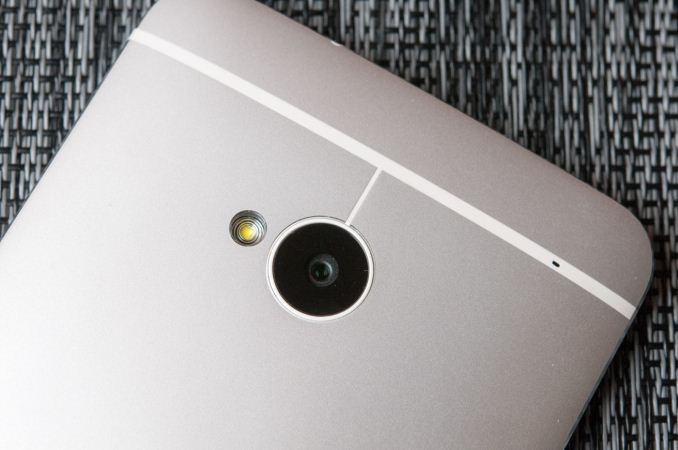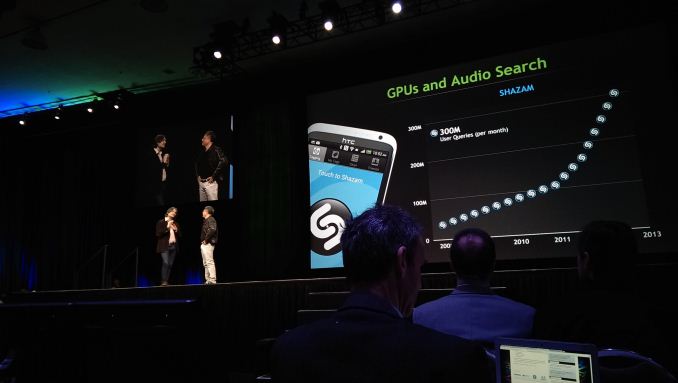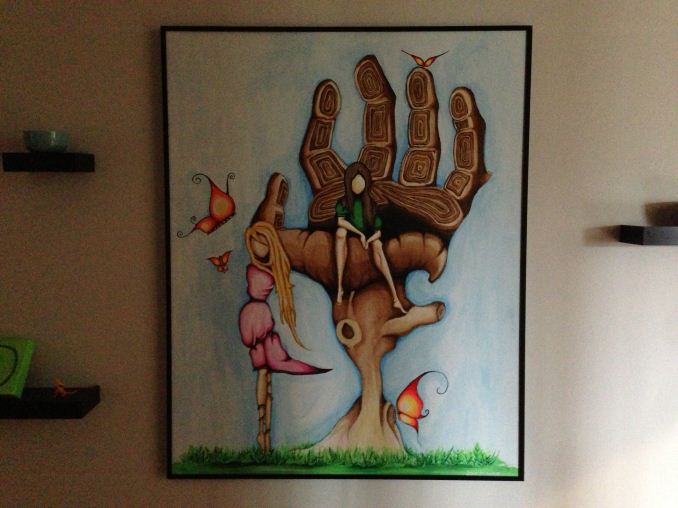The HTC One: A Remarkable Device, Anand’s mini Review
by Anand Lal Shimpi on March 21, 2013 4:49 PM EST- Posted in
- Smartphones
- HTC
- Mobile
- HTC One
The Camera
If the One’s industrial design and materials choices make it nice to own, it’s the camera that makes the One a must have. In fact, that’s how it all started for me. I popped my test sim into the One and started carrying it around with my iPhone 5 as I went about the user experience part of my review process. I quickly found myself only taking photos using the One, and using the 5 for everything else. After a few days, the 5 was pretty much only used to check iMessages and answer calls to that number - with the One being used for everything else.
I remember talking to Brian after he first learned about what HTC decided to do with the One’s camera system. I believe he said something like “this is exactly what they should be building”. In the three years I’ve worked with Brian I don’t think I’ve ever heard him say that about any smartphone OEM’s decision with any component/subsystem. The strong endorsement was enough to pique my interest in the One.
Brian will go into great detail about the One’s camera in his review, and what I’ll provide here is no where near doing it justice but I’ll do my best.
At a high level, HTC’s strategy with the One is to boldly bow out of the megapixel race and instead integrate a lower resolution rear facing camera sensor with larger pixels. Each pixel in the One’s 4MP rear facing camera sensor is over 2x larger than those in the iPhone 5, and even larger than those in the Galaxy S 4. Larger pixels help ensure a better signal to noise ratio, which in turn can really improve low light performance when paired with a suitable lens.
The downsides are obvious. Very well lit scenarios can suffer compared to a higher resolution sensor, and the bigger issue for HTC is that 4MP doesn’t sound as good to the uninformed consumer compared to the Galaxy S 4’s 13MP rear camera. HTC tried to get around the latter problem by calling its larger pixels Ultrapixels, but then it’s up to point of sale training to ensure that the benefits are adequately conveyed. Call me cynical but I don’t have a bunch of faith there.
The F2.0 lens ensures a bunch of light can hit the sensor, and the result is easily the best low light performance I’ve ever seen in any Android or iOS smartphone. I took this shot during Jen-Hsun’s GTC 2013 keynote earlier this week:
The One seems to want to drive ISO as high as possible to increase brightness, so for this particular shot I manually set ISO down to 100, but otherwise everything else was left to defaults.
The Auto ISO algorithm doesn’t always drive itself super high however, the shot below is outside of Terminal 2 at the RDU airport at 11:29PM:
For this shot I didn’t touch anything and the result was a surprisingly low-noise shot.
It’s not just night shots where the One’s camera excels, but also in the more common poorly lit indoor scenarios where I come away very impressed:
HTC One
In well lit outdoor scenes the One’s camera does a reasonable job (although HTC seems to have an issue with noise in these well lit scenes from whatever processing they seem to be doing):
Integrating a good sensor and camera system is just part of what the One does really well here. The feature that I’ve found resonates the best among normal smartphone users is the highlights reel.
Sense 5.0 will automatically assemble 30 second highlights videos based on photos and video you’ve taken throughout your day. The One automatically adds filters, background music and stitches everything together; all you have to do is use the camera to take photos and video, everything else happens automatically.
The highlights reel below is one that was automatically generated based on my photos and videos from opening day at GTC 2013:
Although highlights reels are automatically generated, you can also generate highlights of individual albums. I created an album of photos I had taken over the past couple of trips (as well as some shots I took at home) and the One created this video:
Each highlights reel is shared as standard MP4 (baseline profile, ~3Mbps 720p H.264), so compatibility isn't a concern.
You can manually choose from multiple themes (filters/music combinations, 6 total), but there’s unfortunately no way to add your own background music yet (I suspect this is coming in the next major update).
The highlights reel is easily the most emotionally engaging feature the One has to offer, even ranking above aesthetics and build quality in my opinion. It’s the type of feature that really seems to resonate with everyone I show it to. The killer aspect in all of this is the fact that the One will put together highlights reels automatically, with no user intervention.
I can see the background music and filters getting boring after a while, and that’s why it’s very important for HTC to quickly enable end users to supply their own audio tracks (as well as quickly - and regularly - expand the collection of filters offered).
The downside to the One’s highlights reel autonomy is the feature remains relatively buried, almost hidden in the gallery app rather than front and center like Blinkfeed. The highlights reel is easy to demonstrate to someone else, it’s just not as obvious of a feature when you pick up the phone for the first time.
I haven’t touched on Zoe, the ability to simultaneously shoot stills and record a short video - both at full res. Zoe is a difficult feature to really explain without demonstrating it, but it does wonders in the creation of highlights reels. Zoe is a great way of dealing with the problem of what to do when your subject is in motion - do you hope for a good still or just capture a video? Zoe interestingly enough does both. It’ll capture a 1080p30 video, as well as 20 full resolution (4MP) stills at the same time.
I’ve mostly been using Zoe as a way to make my highlights reels more interesting, but the best use case I’ve seen was actually by a friend of mine who used it to capture the actions of some street performers in Europe. In one Zoe he had performers spinning on their heads, which typically would make for a good video or an emotionless (but potentially cool) still. Zoe delivered both.
The One, like Nokia’s Lumia 920, features optical image stabilization (OIS), which is designed to help both in shooting video as well as improving low light performance. In practice, I’m not super impressed with the OIS implementation on the One. It seems to need a bit of tuning, but I’ll leave it to Brian to explain exactly what’s going on.
Shot to shot latency on the One is amazing. Video quality is solid as well.
The One has the physical beauty to get you interested, but the camera prowess to keep you engaged.
















434 Comments
View All Comments
evonitzer - Friday, March 22, 2013 - link
I was thinking the same thing. 1280x720 = 340ppi in 4.3 inches. Back it up with some decent hardware and I think we'd have a winner. Perhaps they could go the Nokia route with their cheap phones and make it thicker and plastic (and maybe crazy removable backs?) so we could see if people really are interested in a thicker phone with good innards. Price it like the Nexus 4, and I would snap it up in a heartbeat.Mook1e - Friday, March 22, 2013 - link
I'm just going to post two anecdotes with regards to both removable batteries and microsd storage.Let me caveat my statements by admitting I own a Galaxy Note 2 and am an advocate for both features.
I was recently working with someone who had 2 iphones on Verizon simply so that he could have double the battery life. He didn't use an external charger, but instead called Verizon and deactivated and then activated the iphones when the battery died on his first phone! Ridiculous.
I always carry two batteries for my phone, even though the Note 2 lasts 2 days with moderate use. I've just gotten into the habit and it's great to have the simple option if I am away from power unexpectedly.
I was also recently snowboarding in Keystone, Colorado using my Note 2 for music and a GoPro to record my runs.
I had purchased a 64GB microsd for the Note 2 and a 16GB microsd (with sdcard adapter) for the GoPro. I would swap the chips and watch my runs on the gondola back up to the top of the mountain. Needless to say, the glorious huge screen (even though not fullhd) of the Note 2 and the fact I was even able to swap cards was awesome, and numerous fellow gondola riders stated the same when I did it.
These incidences have only happened in the last 2 WEEKS and they perfectly demonstrate the flexibility you have with those two simple design choices.
One more thing about this mini review.. why is it every other review/preview of the One and S4 has indicated that while the One has good low-light camera performance, overall its camera is of lower quality to the S4/Z chip and S4 software? Just wondering.
Death666Angel - Friday, March 22, 2013 - link
To your last point: Anand did state:"In well lit outdoor scenes the One’s camera does a reasonable job (although HTC seems to have an issue with noise in these well lit scenes from whatever processing they seem to be doing)"
Which shows that he thinks that in that scenario, it is only par for the job or even below par. And I don't think he has a G4 to compare with, hence no comparison to that. :)
Mook1e - Friday, March 22, 2013 - link
That's all well and good, but in his S4 comparison he implies the One has better camera quality versus the S4's list of features. Better low-light quality, but arguably worse quality overall.Can we have some honesty, please?
phillyry - Tuesday, March 26, 2013 - link
Mook1e,Try listening to the podcasts and/or reading Brian's article on optics - that's what's biased Anand. He respects Brian's knowledge and understanding of optics and smartphone cameras and is likely placing some faith in Brian's assertion that the One is going in the right direction when it comes to smartphone cameras.
nerd1 - Tuesday, March 26, 2013 - link
Actual sample pics says elsewise.Mook1e - Friday, March 22, 2013 - link
I'm just going to post two anecdotes with regards to both removable batteries and microsd storage.Let me caveat my statements by admitting I own a Galaxy Note 2 and am an advocate for both features.
I was recently working with someone who had 2 iphones on Verizon simply so that he could have double the battery life. He didn't use an external charger, but instead called Verizon and deactivated and then activated the iphones when the battery died on his first phone! Ridiculous.
I always carry two batteries for my phone, even though the Note 2 lasts 2 days with moderate use. I've just gotten into the habit and it's great to have the simple option if I am away from power unexpectedly.
I was also recently snowboarding in Keystone, Colorado using my Note 2 for music and a GoPro to record my runs.
I had purchased a 64GB microsd for the Note 2 and a 16GB microsd (with sdcard adapter) for the GoPro. I would swap the chips and watch my runs on the gondola back up to the top of the mountain. Needless to say, the glorious huge screen (even though not fullhd) of the Note 2 and the fact I was even able to swap cards was awesome, and numerous fellow gondola riders stated the same when I did it.
These incidences have only happened in the last 2 WEEKS and they perfectly demonstrate the flexibility you have with those two simple design choices.
One more thing about this mini review.. why is it every other review/preview of the One and S4 has indicated that while the One has good low-light camera performance, overall its camera is of lower quality to the S4/Z chip and S4 software? Just wondering.
name99 - Friday, March 22, 2013 - link
"For what it’s worth, if I had to estimate I’d say design work on the One probably started before the iPhone 4S came out."I don't know about that. The champfering, in particular, seems so much an iPhone5 design cue that isn't forced by the overall design concept. But that's not what I want to discuss.
What I find interesting here is the question of how much profit HTC makes on these devices, which I suspect are crazy expensive to make. My larger thinking is based on the question of: "how is Apple competing", a question that is constantly answered on the internet by reference to what Apple was doing 18 months ago rather than what Apple is doing today, let alone next year.
At first Apple competed on the basis simply of having a smartphone that actually was a smartphone, not a piece of crap like every competitor.
This persisted until Android became at least marginally viable (around 2.2 or so) at which point the competition shifted to screen quality. This was the basis of competition for two years or so until Apple's exclusivity contracts ran out, or perhaps until competitors managed to retool for retina displays.
Both of these features (OS quality and screen quality) remain Apple selling points, and Apple fanatics will point out ways in which they remain superior; but their superiority is now a matter of degrees and opinion, not the qualitative difference of before.
So what's the new basis for competition. I submit that it is build quality. The iPhone5 is a truly astonishing device to hold. The iPhone1 (and 3G and 3GS) had really obvious seams and edges; even the iPhone 4 and 4S had noticeable edges. But the 5 seems like it is almost organically grown in its perfection. And so it provides an answer to the question "Why should I pay more for an iPhone".
Samsung does not (as far as I can tell) appear interested in competing along this dimension. (Whatever other people have said about SGS4, they have not raved about its build quality as something new.) This may be because they haven't had time to retool; or it may be that Samsung simply appreciate that their customers are not willing to pay for this --- there's no shame in selling a Honda Civic at Honda Civic prices, the only shame is pretending your Civic is a Mercedes.
HTC, on the other hand, seem to have decided this is a space in which they want to compete; and at least from the photos they seem to have succeeded --- I haven't seen one in real life, so don't know if there are non-obvious problems. This may make sense for them, catering to the Android-loving set who are willing to pay more (BMW to Apple's Mercedes); but it all hinges on whether they can make a profit. Apple have invested (we know this from a variety of clues) a MASSIVE amount, like billions of dollars, in tooling and in learning over the years, to get to the point where they can make an iPhone5, sell it at the price they do, and make a profit.
It's not clear to me that HTC can make the economics work in the same way.
Which is a shame --- high-end competition for Apple benefits us all; but if I had to bet, my betting would be on HTC going broke over this, not on it saving HTC. I expect the end-game will be some sort of merger --- MAYBE Samsung buying HTC, but more likely either one of the Taiwan computer companies or maybe nVidia.
haze4peace - Sunday, March 24, 2013 - link
Hey thanks for the insightful post.nerd1 - Tuesday, March 26, 2013 - link
CNC machining has been around for decades and it does not cost that much ($2-$3 i guess)And apple havent invested anything to improve cnc technology either. Literally anyone can uae machine if they are willing to do - see nokia, htc, and even samsung (their series 9 laptop has cnc unibody)
Also apple has way higher margin than even samsung who makes most parts in house. All other OEMs uses obviously better display, larger ram, better ap, larger battery... Apple products are not BMW, they are polished civics with BMW prices.